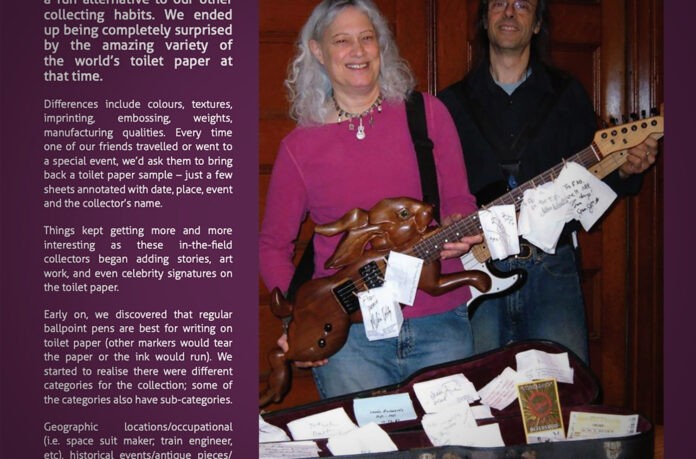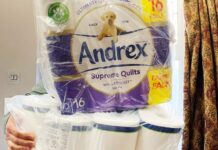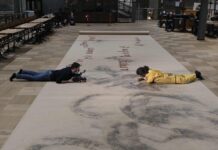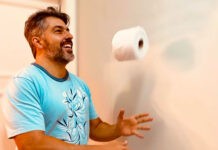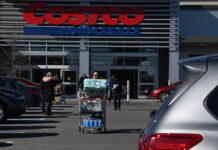From the Kremlin to the McMurdo Station in The Antarctic and with celebrity signatures including Madonna and Woody Allen, Boston, Massachusetts couple Rich and Flo Newman have amassed a tissue treasure trove.
We started collecting toilet paper in 1978 as a fun alternative to our other collecting habits. We ended up being completely surprised by the amazing variety of the world’s toilet paper at that time.
Differences include colours, textures, imprinting, embossing, weights, manufacturing qualities. Every time one of our friends travelled or went to a special event, we’d ask them to bring back a toilet paper sample – just a few sheets annotated with date, place, event and the collector’s name.
Things kept getting more and more interesting as these in-the-field collectors began adding stories, art work, and even celebrity signatures on the toilet paper.
Early on, we discovered that regular ballpoint pens are best for writing on toilet paper (other markers would tear the paper or the ink would run). We started to realise there were different categories for the collection; some of the categories also have sub-categories.
Geographic locations/occupational (i.e. space suit maker; train engineer, etc), historical events/antique pieces/ creative artistic (i.e. elaborate drawings on the paper; poetry, etc.), celebrity signed (including musician-signed toilet paper), bookmarks/lengthy pieces that are signed by groups of people; pieces with interesting stories …
After we had created a website for our band Tagyerit’s music in 1995, we decided to have fun with our website and add some of our other interests. We called the toilet paper collection “The Whole World Toilet Paper Museum”, though it’s a museum in name only, since it’s visible on the internet throughout the world.
Then, people we didn’t know began contributing pieces and we even received some other people’s collections. We were really surprised to find out how many old and antique pieces of toilet paper actually survived in their original condition.
The collection numbers about 1,500 annotated pieces. Here are just a few of the examples:
• A clown shoemaker in Massachusetts signed a piece of toilet paper for us. He made half the shoes for the movie The Grinch Who Stole Christmas.
• A friend was questioned by police when she left her bags unattended when she ran to get us toilet paper from the ferry station in Ireland. Unfortunately, she missed her boat and had to wait until the next day.
• Madonna signed a piece when she was working on the movie set of League of Their Own.
• Woody Allen signed a piece at the Cannes Film Festival and wrote on the toilet paper “Why This?”
• A piece from the Kremlin when Gorbachev was under house arrest during an attempted coup d’etat.
• McMurdo Station in the Antarctic signed by the entire janitorial staff.
We’ve watched the quality of toilet paper from around the world change over these decades. Now it’s becoming more standard soft and white, which is unfortunate for us as we revel in the vast variety of shades of colour and textures that used to be so prevalent.
At home, the majority of our tissue use is for toilet paper. We do use a small amount of paper towels and paper napkins, but probably a package of each lasts us a year. Our goal in tissue use, as in much of our other purchases, is to be as environmentally-friendly as possible.
For many years, we have bought recycled tissue, but lately have found tree-free options which is actually kind of exciting. A year ago, as a gift, a friend bought us 100% bamboo toilet paper from an online store, Who Gives a Crap (whogivesacrap.org).
Not only is it environmentally-friendly, but these people donate 50% of their profits to bring toilets to places that have none. It’s reasonably priced, and they market it with a sense of humour too.
While buying environmentally-friendly products should be obvious, it bears repeating and reminding. Current populations as well as future generations should live in a world of plenty and beauty with an earth full of healthy forests.
Ideally, the products we use should be sustainably made with as little energy as possible and with zero pollution. Our grandchildren will thank us for it.
Flo and I both grew up in or around Boston, Massachusetts, in the 1950s. Good strong quality tissue was all around. In diners, the dispensers were filled with paper napkins and only in the fanciest restaurants were cloth napkins provided.
Television commercials were filled with competing claims of which paper towel was strongest or most absorbent. And which toilet paper was softest or even most ‘squeezable’.
We’re not big travellers, and that is part of the original impetus for our collection. In 1978, a friend was flying to Europe and asked us what we’d like her to bring us back.
Partly in jest, we asked for toilet paper samples from places she visited. We figured it provided her a free and lightweight option for bringing us souvenirs of her travels. Little did we know it was the start of a small empire.





















